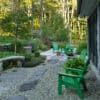 A straight, narrow front walk A curved, wider front walk
A straight, narrow front walk A curved, wider front walk
Images from Home Outside: Creating the Landscape You Love, p. 118
Bobbie writes:
Dear Julie:
How often, when visiting a client for the first time, do you approach the front door by means of a narrow concrete sidewalk (front walk) that has only enough width for one person at a time? Keeping in mind the fact that visitors frequently arrive in pairs, don’t you think a sidewalk should be wide enough for two people to walk side by side? That concrete sidewalk is most often stark white although time and the weather may have dimmed the color a bit but why couldn’t the walk be created with tinted concrete that complements the color of the house? Nor does the walk have to be an L-shape composed of two straight lines, one from the driveway and then the perpendicular to the front door. It’s certainly the cheapest method of constructing a sidewalk but far from attractive.
Another problem with such sidewalks is that they are usually set out only a few feet from the house, thus creating very shallow planting beds between the house and the walk. Then plants are arranged like soldiers because there is insufficient space to create a composition. One of the essential elements of composition is layering, i.e.groupings of plants that have different heights, forms, and textures. This type of composition creates interesting landscapes that, hopefully, change with the seasons. When you are given the opportunity to change these beds, usually by ripping out the existing walk, remember to create a shape that echoes or works off of the lines of the house. Also keep in mind that foundation plantings did not always exist. In England of the 1500’s and 1600’s, lawn came all the way up to the house. Foundation plantings came into existence when the foundations of homes were raised. At that time, plantings were used to hide the ugly foundations. Even though such an imperative no longer exists, the tradition has continued.






